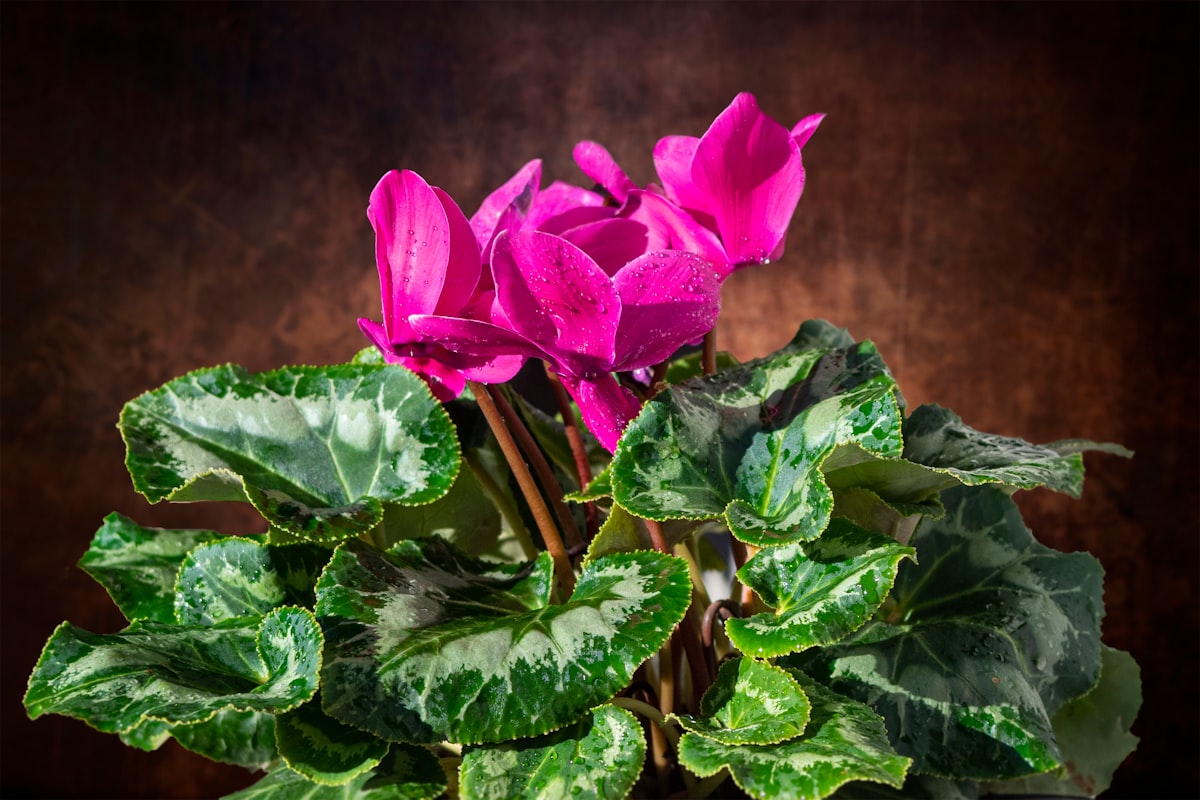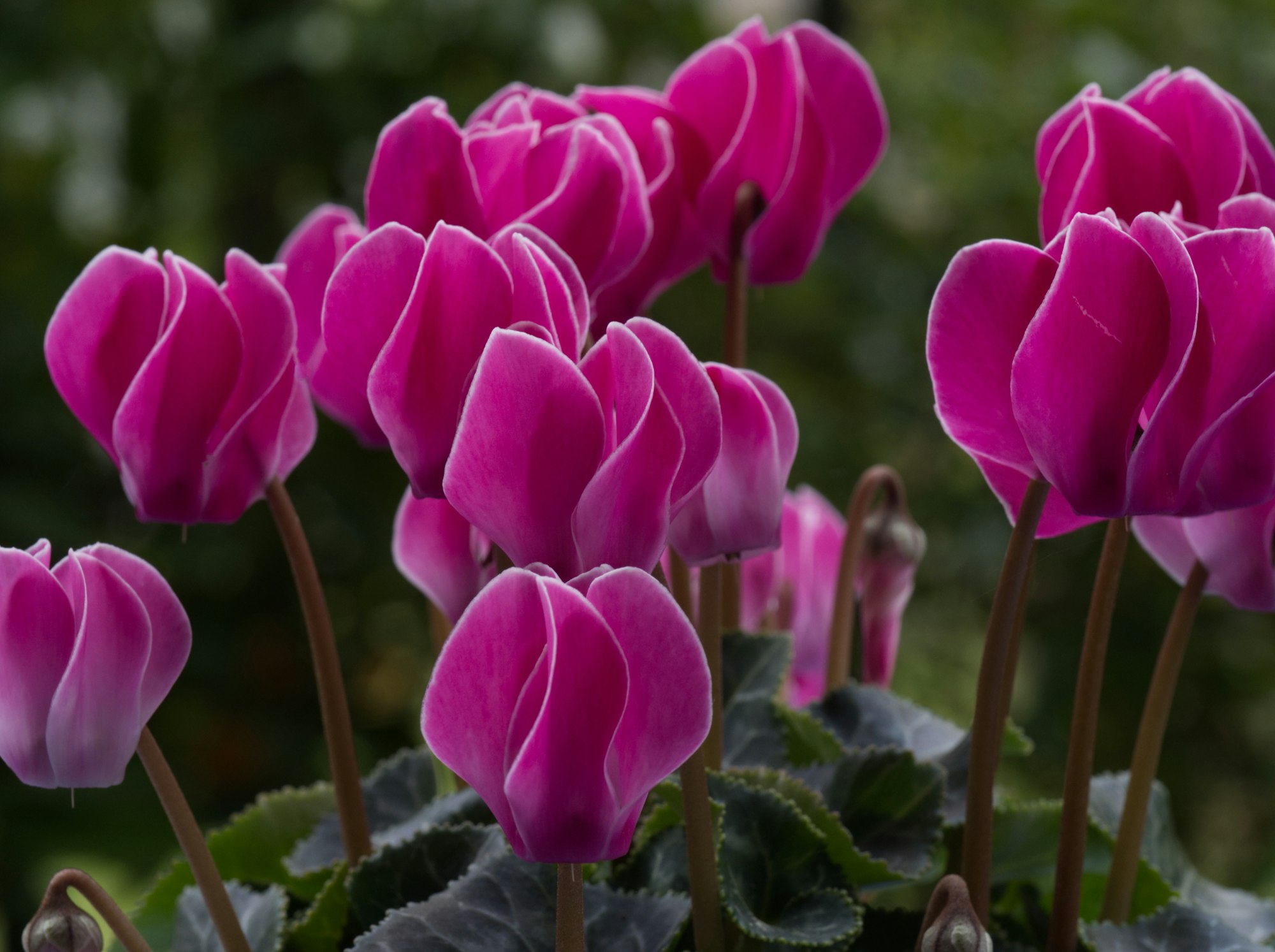How to Grow Cyclamen
Cyclamen is a beautiful flowering plant known for its vibrant, frilly flowers and silver-mottled, heart-shaped leaves.

Table of Contents
Growing Cyclamen, whether as a houseplant or ground cover, brings a touch of elegance and color to your space, especially during winter when the blooming is at its peak.
To successfully grow Cyclamen, it's essential to provide the right conditions.
Focus on giving your plant bright, indirect light, well-draining, slightly acidic soil, and consistent watering during its active growth period.
By taking the proper care, you can enjoy the unique charm of Cyclamen and brighten up your home or garden.
About Cyclamen
Cyclamen, a perennial plant commonly referred to as Persian Violet belongs to the family Primulaceae.
Boasting vibrant red, white, and pink flowers, its heart-shaped leaves exhibit unique silver-mottled foliage, which adds to the beauty of this Mediterranean native.
Cyclamen persicum, or florist's Cyclamen, is a popular variety known for its attractive foliage and crown-like formation.
On the other hand, Hardy cyclamen can withstand cooler temperatures, making both types great options for indoor houseplants and outdoor ground cover in shaded areas.
Remember to provide well-draining soil and indirect light for optimal growth and care.

Growing Cyclamen
To start planting Cyclamen, select well-drained soil in a shady location in your garden.
Incorporate organic matter and ensure drainage holes using pots with potting soil.
For tuberous perennials like Cyclamen, plant the tubers at the appropriate depth, usually 1-2 inches below the soil surface, providing enough space, such as a distance of 6-10 inches apart.
Cyclamens prefer soil that stays consistently moist but not soggy, so monitor the moisture levels as the plant grows.
The plant thrives best in bright, indirect light and cool temperatures, with purple and white flowers rising above attractive dark green foliage.
As your Cyclamen grows, it will reach a mature height of 6 to 12 inches indoors, while hardy species can reach up to 24 inches when grown outdoors.

Caring for Cyclamen
Sun and Temperature
Cyclamen prefer bright, indirect light in the winter when actively growing.
In the summer, during dormancy, keep your Cyclamen in a cool, dark spot with good air circulation.
Water and Humidity
Constantly water Cyclamen from the bottom by placing it in a water tray and allowing the plant to absorb the moisture.

This will help avoid overwatering and keep your plant healthy.
Soil
Plant Cyclamen in rich, well-draining soil. Use loamy, slightly acidic soil with added compost or a mix of equal parts potting soil and compost for best results.
Fertilizer
Fertilize Cyclamen periodically with a diluted balanced liquid fertilizer during the growing season. Avoid fertilizing during the plant's dormant period.

Repotting
When repotting Cyclamen, choose a slightly larger container with drainage holes at the base.
To ensure good drainage, fill the pot with a well-drained soil mixture.
Pruning and Propagation
To propagate Cyclamen, collect seeds during the blooming period, then sow and care for the seedlings until they are ready to be transplanted.
Prune away any dead or yellowing foliage to encourage healthy growth.
Troubleshooting Plant Problems
Growing Problems
Cyclamen needs a dormant period, so ensure you provide the right light, temperature, and humidity conditions.
During dormancy, keep your plant in a cool, dark spot with good air circulation.
For soil, opt for well-draining potting soil to prevent overwatering. Water Cyclamen properly by letting the soil partially dry out between waterings.
Pests and Diseases
Cyclamen may suffer from pests and diseases like mites, aphids, Fusarium Wilt, or Botrytis.
To minimize these issues, maintain the right climate conditions and clean your indoor plants for a healthy environment.
If you notice yellowing leaves or signs of pest infestation, treat the affected plant and isolate it to avoid spreading the disease.
For fungal infections, improve drainage by amending the soil and using containers with holes at the bottom.
Companion Planting

When choosing houseplants to grow alongside Cyclamen, consider your plants' light, water, and humidity requirements.
Be cautious while pairing it with other plants; Cyclamen has different needs and may not flourish alongside plants requiring different conditions.
Conclusion
Plant Cyclamen in organically rich, well-draining soil with a slightly acidic pH.
Position it near a bright east- or west-facing window to ensure plenty of indirect light, and avoid direct sunlight to prevent wilting.
Water Cyclamen when the top inch of soil feels dry, but avoid splashing water onto the leaves.
Fertilize sparingly when mature, and if needed, adjust care for dormancy periods as temperatures and watering frequency change.
Frequently Asked Questions
What is the best way to plant Cyclamen bulbs?
Choose a well-drained, loamy, and acidic soil to plant Cyclamen bulbs. Plant the bulbs with their top just below the soil surface and space them about 5-10 cm apart.
How do I care for Cyclamen?
Place them in a partially shaded area to care for Cyclamen and moisten the soil.
During their dormancy period in the summer, reduce watering while ensuring that the soil remains slightly damp.
Can Cyclamen be grown from seeds?
Yes, Cyclamen can be grown from seeds. Sow the seeds in a well-draining soil mix and maintain a temperature between 60-65°F (15-18°C).
Keep the soil moist, and expect germination to occur within several weeks.
What are the differences between indoor and outdoor Cyclamen?
Indoor Cyclamen are typically tender varieties like Cyclamen persicum, requiring temperatures between 40-65°F (4-18°C).
Outdoor Cyclamen, such as Cyclamen purpurascens, can withstand lower temperatures and are often more cold-hardy.
Ensure proper care according to their specific requirements.
When does Cyclamen typically flower?
Cyclamen typically flower in the fall, winter, or early spring.
The blooming period varies depending on the species and specific care conditions provided.
Do Cyclamen plants self-propagate each year?
Cyclamen plants can self-propagate, as their tuberous roots produce new offsets.
To encourage propagation, ensure proper care, and maintain optimal growing conditions for your Cyclamen.



